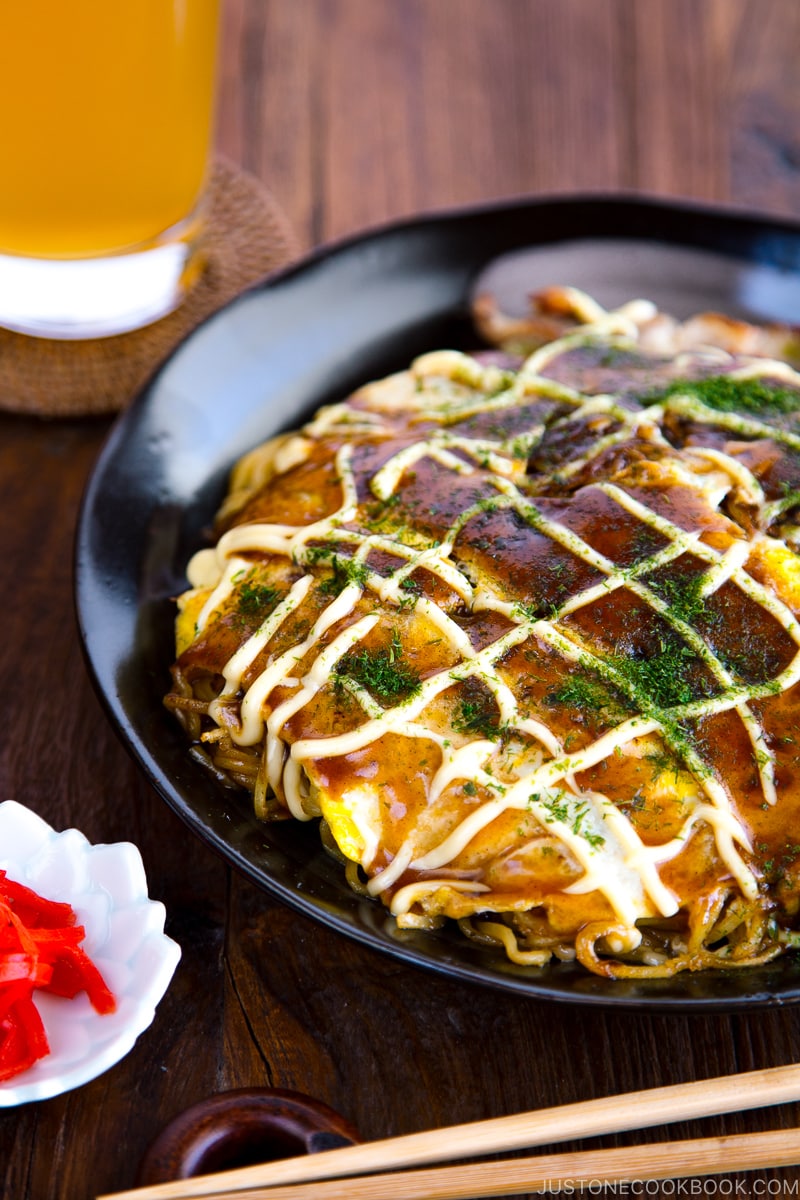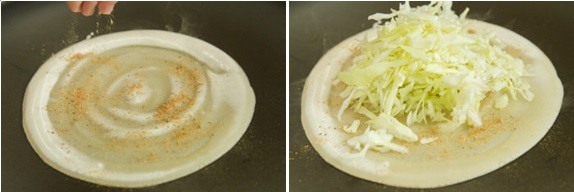Hiroshima-style Okonomiyaki is a Japanese savory pancake layered with yakisoba noodles, fried egg, and pork belly drizzled with a delicious sauce. Watch my video tutorial for step-by-step instructions on how to make this fantastic homemade recipe for lunch or dinner!

Have you tried Okonomiyaki (お好み焼き) before? It’s a Japanese savory pancake that contains a variety of ingredients. “Okonomi” in Japanese means “as you like it”, so it’s a savory pancake that contains whatever ingredients you like.
Hiroshima-style Okonomiyaki (広島風お好み焼き) is a type of Okonomiyaki that originated in Hiroshima, Japan.
Table of Contents
Two Styles of Okonomiyaki


- Osaka-style okonomiyaki – This savory pancake is made of batter, which includes flour and water or dashi, shredded cabbage, egg, and green onion along with the protein of your choice, such as pork belly slices or seafood. You can find my Osaka-style okonomiyaki recipe here.
- Hiroshima-style Okonomiyaki – This savory pancake uses almost the same ingredients, but they are layered rather than mixed in with the batter like Osaka-style. Not only that, fried egg and yakisoba noodles (or sometimes udon noodles) are used as toppings.
Which one is tastier? Well, that’s really up to your preference. If you like fried noodles and a less doughy texture, Hiroshima okonomiyaki is your choice!
I like both styles of okonomiyaki, so it’d be very hard for me to pick just one! At home, I just cook them alternatively.
What is Hiroshima-style Okonomiyaki?
Hiroshima-style okonomiyaki has been around since the 1950s. At that time, the country was quite poor and people only used a little bit of flour and vegetables to make Hiroshima-style okonomiyaki.
The current Hiroshima Okonomiyaki with meat, egg, and noodles is a version that has evolved throughout the years. Nowadays there are over 2,000 restaurants within the Hiroshima area that specialize in Hiroshima-style okonomiyaki!

3 Key Toppings for Okonomiyaki



- Okonomi Sauce – I would say the important and delicious element for both Hiroshima- and Osaka-style okonomiyaki is the Okonomi Sauce (お好みソース). Originally, Worcestershire sauce was used but throughout the years the flavor has evolved to the current flavor. Okonomi Sauce has a sweet and sour flavor that’s slightly different from Tonkatsu Sauce and it’s thicker consistency so it goes well with Okonomiyaki. Oh so delicious!
- Japanese Kewpie Mayonnaise – It has a sweet and tangy flavor that is well-balanced. Many JOC readers have told me that they haven’t gone back to the original mayo they had been using since they tasted Japanese mayonnaise!
- Aonori (dried green seaweed) – It is dried green (Ao) seaweed (Nori) flakes/powder. This umami-rich seaweed has a bright intense green color and has a unique fragrant. Japan has many types of seaweed from wakame, nori, to kombu. We use s specific name for each type of seaweed instead of just calling them “seaweed”. It helps identify which is the correct seaweed for a different type of dishes. You can buy Aonori from Amazon and Japanese/Asian grocery stores. Or you can substitute with regular nori if you can’t find it.

Itadakimasu!
I hope my tutorial video and step-by-step instructions with pictures will help you achieve the delicious Hiroshima-style Okonomiyaki! If you haven’t tried Osaka-style, give it a try next!

Wish to learn more about Japanese cooking? Sign up for our free newsletter to receive cooking tips & recipe updates! And stay in touch with me on Facebook, Pinterest, YouTube, and Instagram.

Hiroshima-style Okonomiyaki
Video
Ingredients
For the Batter
- 150 ml water (⅔ cup minus 2 tsp)
- 1 tsp mirin
- 100 g cake flour (¾ cup + 1½ Tbsp; you can make homemade cake flour; or substitute all-purpose flour in a pinch)
For the Okonomiyaki Layers
- 8.5 oz green cabbage (about 3 large cabbage leaves)
- 1 green onion/scallion
- 2 Tbsp katsuobushi (dried bonito flakes)
- 4 Tbsp tenkasu/agedama (tempura scraps) (12 g)
- 2 oz bean sprouts (about 1 handful)
- 2 Tbsp tororo kombu (dried kelp shavings; you can buy it online; optional)
- 6 pieces sliced pork belly
- 2 servings yakisoba noodles (pre-steamed; about 11 oz, 310 g)
- 2 large eggs (50 g each w/o shell)
- okonomiyaki sauce (you can make my homemade okonomiyaki sauce recipe)
- toppings of your choice (typically aonori (dried green laver seaweed), pickled red ginger (beni shoga or kizami beni shoga), and Japanese Kewpie mayonnaise)
Instructions
- Gather all the ingredients.

- In a large bowl, add 150 ml water (⅔ cup minus 2 tsp) and 1 tsp mirin.

- Add 100 g cake flour (¾ cup + 1½ Tbsp) and whisk until combined. Chill in the refrigerator for at least 1 hour so the texture becomes smooth.

- Meanwhile, use a sharp knife to cut 8.5 oz green cabbage and 1 green onion/scallion into thin slices.

- Grind 2 Tbsp katsuobushi (dried bonito flakes) in a mortar and pestle to a fine powder.

- After chilling for 1 hour, the batter will become smoother.

To Make the Okonomiyaki
- We will make one Okonomiyaki at a time The ingredients are for 2 pancakes, so divide all the ingredients into 2 portions.
- Heat a large nonstick griddle (I use an electric griddle at home) to 340°F (170°C). Pour ¼ cup batter onto the hot griddle. Immediately spread the batter thinly into a large circle with the back of the ladle, starting at the center and spiraling the batter outward (see the video) to a diameter of 8–9 inches (20–23 cm).

- Now, start layering your ingredients. Sprinkle this “crepe“ with 1 Tbsp ground katsuobushi. Then, scatter a portion of sliced cabbage on top.

- Next, top with 2 Tbsp tenkasu/agedama (tempura scraps), some of the sliced scallion, and 1 oz bean sprouts.

- Add 1 Tbsp tororo kombu on top, if using. Then, add a single layer of 3 pieces thinly sliced pork belly without overlapping.

- Pour 1 Tbsp batter on top (this will act as glue). With two spatulas, one in each hand, carefully pick up the pancake from either side and quickly flip. Turn the heat to 390°F (200°C) to cook the meat. Use the spatula to push the edges of the meat toward the rounded pancake shape. Don’t press down the crepe with the spatula yet (you will do so later). When the meat is no longer pink, turn down the heat to 340°F (170°C) and move the Okonomiyaki to the side. If you are using a frying pan instead of the griddle, heat up a second pan.

- With your hands, loosen 1 serving yakisoba noodles and place them in the open space on the griddle (or the 2nd frying pan). Stir-fry until the noodles are coated with the rendered oil from the meat. Next, drizzle 1–2 Tbsp okonomiyaki sauce on the noodles and toss to coat.

- Form the noodles into a round flat shape similar in size to the crepe. Using the two spatulas, quickly transfer the Okonomiyaki on top of the noodles.

- Heat some neutral oil in the open space and crack 1 large egg. Quickly spread the egg into the same size as the Okonomiyaki.

- Before the egg is completely cooked, place the Okonomiyaki on top of the egg (see the video).

- When the bottom of the egg is cooked, flip the Okonomiyaki for the last time using the two spatulas.

To Serve
- Transfer the okonomiyaki to an individual plate and drizzle with okonomiyaki sauce. Customize with the condiments and toppings of your choice. I recommend drizzling Japanese Kewpie mayonnaise in a zigzag pattern and sprinkling aonori (dried green laver seaweed) on top. Garnish with pickled red ginger (beni shoga or kizami beni shoga), if desired. Serve immediately.

To Store
- You can keep the leftovers in an airtight container and store in the refrigerator for 3 days or in the freezer for a month.




























Wonderful!
Takes me back to Okinawa.
Hi Casey! We are glad to hear you enjoyed Nami’s recipe!
Thank you so much for your kind feedback. Happy Cooking!
When I was on a tour of the Wood Egg Okonomiyaki museum in Japan, each visitor was given a bottle of freshly made Otafuku okonomiyaki sauce. So I had to try your recipe back home after the trip to Japan. My daughter said to keep your recipe, it tasted “legit” to her, similar to the okonomiyaki we ate in Hiroshima. Only thing is, the batter was too thick when I followed the water & flour quantities in the recipe, it was not as smooth flowing as shown in the video, so I had to keep adding water to make it the same consistency as in the video . Perhaps there is a typo in the recipe?
Hi Bernie! Thank you so much for reading Nami’s post and trying her recipe! We hope you enjoy your visit to the Okonomiyaki Museum. Yes! We hope the sauce tastes comparable to what you’ll taste in Japan. 😉
As for the batter, what type of flour did you use? It might be the type or brand of flour you used, or if you used the cup to measure the ingredient, it may have packed too much flour. If you haven’t used the scale before, we highly recommend it. We hope this is helpful.
I used plain flour, and used the food weighing scale using the metric measurements in the recipe. For the water, I used a measuring cup. That’s why I wondered whether the recipe had a typo for the flour and water.
Hello, Bernie. I had Nami double-check her recipe, but there seemed to be no errors. Maybe it got overmixed?
Is there anything you would recommend substituting for egg? My daughter is obsessed with Japanese culture and I would love to make this for her, but she has dairy and egg allergies. This was my favorite dish I enjoyed when I visited Japan so I would love to be able to share such a wonderful dish with her!
thanks!!
Hi Shelly! Thank you very much for reading Nami’s post and trying her recipe!
You can skip the fried egg or make another crepe instead.
We hope you and your daughter enjoy this dish!☺️